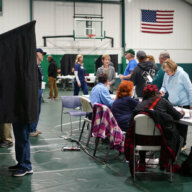As Occupy Philly’s tent encampment grows, so does the community’s homeless population, which worries some of the group’s leaders.
“It makes sense. Ninety-five percent of what we do here helps the homeless – meals, housing, shelter,” said Rob Hunter of the comfort committee. “We’re here to stand up for the 99 percent and they’re certainly the most vulnerable.”
The issue has caused tension among Occupiers as some committees are feeling the pressure of resource strain in terms of both supplies and manpower more than others.
“The homeless have outnumbered the Occupiers,” an organizer with the safety committee said. “We are totally overwhelmed. We don’t have the training or social services to meet their needs.”
She said that it has been difficult for her to participate in the political side of the movement because she is constantly dealing with effects of attendant drug and mental health issues that often compound the problem of homelessness.
Still, many other Occupiers welcome the community, and they are becoming better integrated with the movement. “We invite them quite a bit,” said Steve Ross of the media committee. “When I’m walking on the street, I say, ‘Come here, there’s free food,’ and a lot of them do.”
The city’s Office of Supportive Housing said that city shelter numbers, which hover around a 96 percent occupancy rate, have not seen any decrease. But she also noted that Center City has a robust street homeless population.
“It was a little rough in the beginning, but a lot of the homeless volunteer,” Hunter said. “We’re like neighbors, now.”
Don’t compare
Dainette Mintz of the Office of Supportive Housing said that Occupiers are ill-equipped to provide the services the homeless population needs.
“It appears that they don’t realize that we, unfortunately, already had a street homeless population before they arrived that occupied the plaza,” she said. The department’s last count estimated 370 street homeless in Center City alone.
“If they are not providing people with a permanent housing plan, then I don’t think they compare to what the city does.”
There are about 810 people out of 977 beds at the city’s single male shelters





























